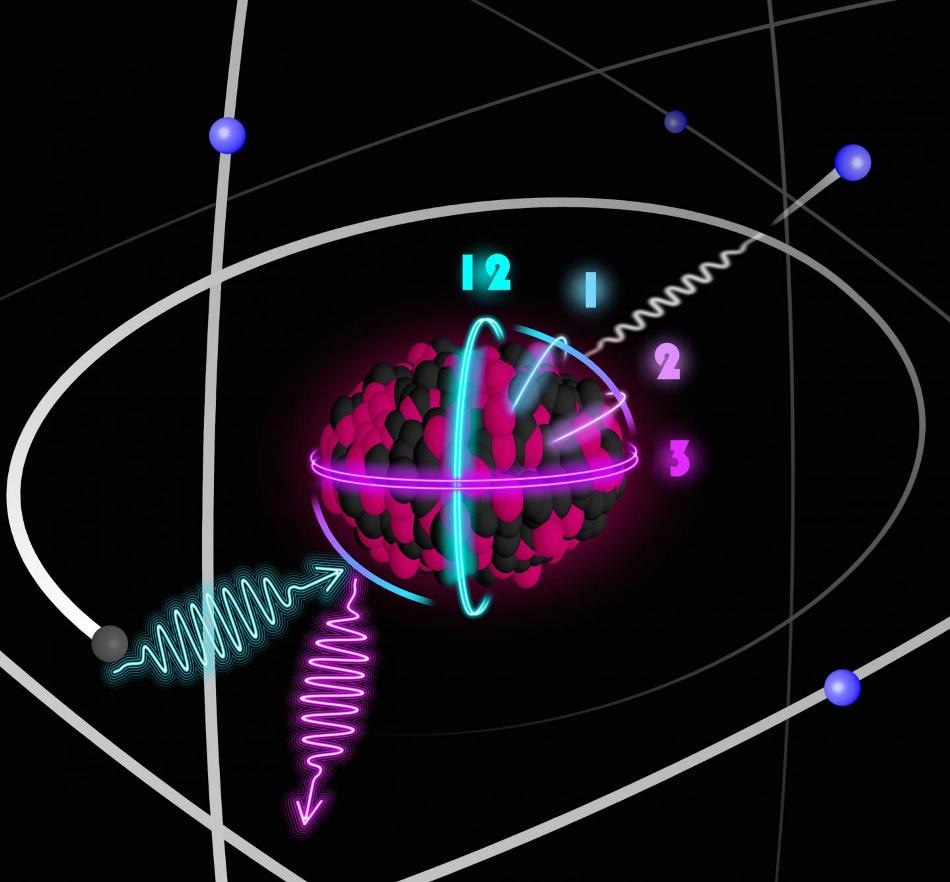Sep 12 2019
Building the most precise clock in the world requires something that “ticks” extremely fast and extremely accurate. Electrons used in the case of an atomic clock can be switched back and forth between two distinct states in a way that is defined very precisely.
 Thorium nuclei could be used to create ultra-precise clocks. (Image credit: TU Wien)
Thorium nuclei could be used to create ultra-precise clocks. (Image credit: TU Wien)
However, a nuclear clock would be even more precise, as it does not use states of electrons, but intrinsic states of the atomic nucleus.
For several years, people have been looking for appropriate atomic nuclei for this purpose, and for a long time, it had been presumed that a particular thorium isotope must possess a nuclear state that would be appropriate for building a new generation of high-precision clocks.
For the first time, this long-awaited core state of thorium has been displayed experimentally—two times, by two different international research groups. TU Wien has a vital role to play in both experiments. Now, the outcomes of the two experiments have been reported simultaneously in the Nature journal.
Two Adjacent Energy Levels
In nuclear physics we usually have to deal with very high energies. The energies of the electrons orbiting the atomic nucleus are usually much lower, so it is relatively easy to manipulate these electrons with laser light. This is usually not possible with atomic nuclei.
Thorsten Schumm, Professor, TU Wien
However, nuclei of the thorium isotope 229 are a fascinating anomaly: “Just above the ground state—the state with the smallest possible energy—there is, surprisingly, another nuclear state, which we call isomer,” stated Thorsten Schumm.
The difference in energy between these two nuclear states—the isomer and the ground state—is several orders of magnitude smaller compared to the difference between energy levels in other atomic nuclei. It is almost equivalent to the energies of electrons. At present, Thorium-229 is the only nucleus with such a low-energy isomer state.
The shift between the two thorium nuclear states is a perfect foundation for building an innovative precision clock. It is possible to measure nuclear states much more precisely than electron shell states that are used in existing atomic clocks.
Moreover, the atomic nucleus is guarded against perturbations in a much better way, for example, from external electromagnetic fields. To date, the major problem was that the precise energy value of the strange thorium isomer state was not known.
Complicated Measurement Method
Since the search for this core condition is challenging and laborious, a number of teams joined hands: Research teams from Germany and Austria (LMU München, MPI Heidelberg, and TU Wien) formulated a technique for detecting the intended isomer state: Electrically charged thorium ions are formed during the decay of radioactive uranium 233 nuclei; 2% of these ions end up in the intended excited isomeric state.
These thorium ions are electrically neutralized again by guiding them through a thin graphene layer, from which the thorium ions trap the missing electrons. Then, the neutral thorium atoms can impulsively shift from the excited nuclear state to the ground state. This leads to energy release—an electron is tossed away.
This electron’s energy is measured; in case all details of the challenging experiment can be controlled and calculated accurately, it would be possible to deduce the energy of the thorium nucleus state. Thorsten Schumm and Simon Stellmer assisted in formulating the experiment; Florian Libisch and Christoph Lemell performed computer simulations needed for a quantitative estimate of the isomer energy.
Simultaneously, a totally different experiment was performed in Japan; Thorsten Schumm from the TU Wien took part in this study as well. In this experiment, a synchrotron was used that generates highly intense X-rays.
Upon irradiating the thorium nuclei with these rays, it is possible to transfer them to the second excited nuclear state with an energy of more than 1000 times greater than the isomer state. From this state, the thorium nuclei subsequently decay mainly into the intended isomeric state, close to the ground state—the atoms, which are actively “pumped” into the isomer state, can be measured in that state.
Numerous Possible Applications
“This is an extremely important step for us: not only do we know that the excited state actually exists just above the ground state, we also know its energy quite well now,” stated Thorsten Schumm. Through additional measurements, the state will be measured even more accurately.
Then, it should be feasible to use it for developing compact, high-precision atomic nuclear clocks. Clocks such as these would pave the way for entirely new research possibilities: They would be an excellent tool for fundamental research, for instance, to analyze dark matter or to measure whether our natural constants are precisely constant in real time.
Besides this, an atomic nuclear clock would enable many other highly precise measurements, which may be only indirectly related to measuring time. These include the measurement of minute irregularities in the gravitational field of the Earth or the more accurate positioning of objects with the help of satellite-based navigation.